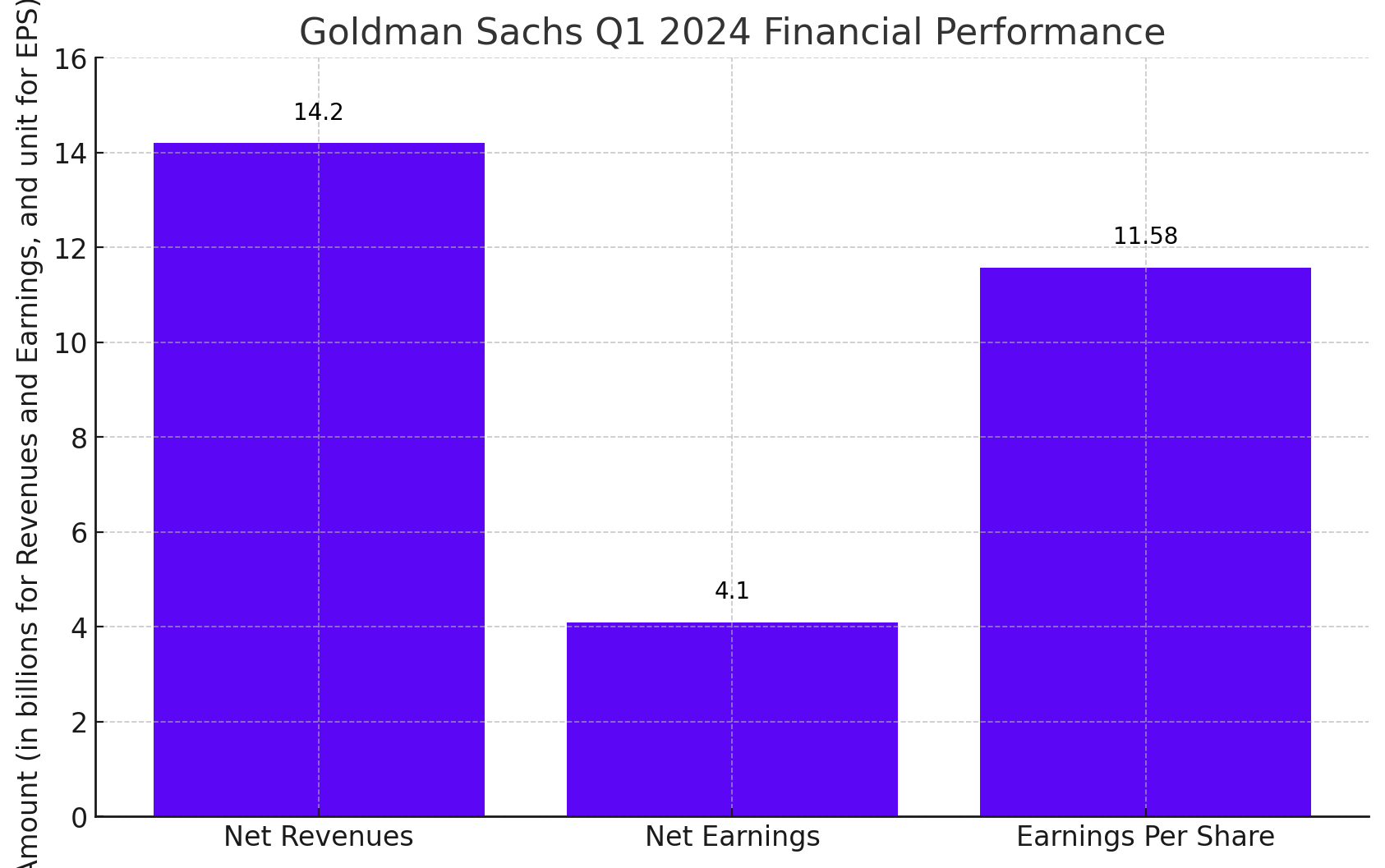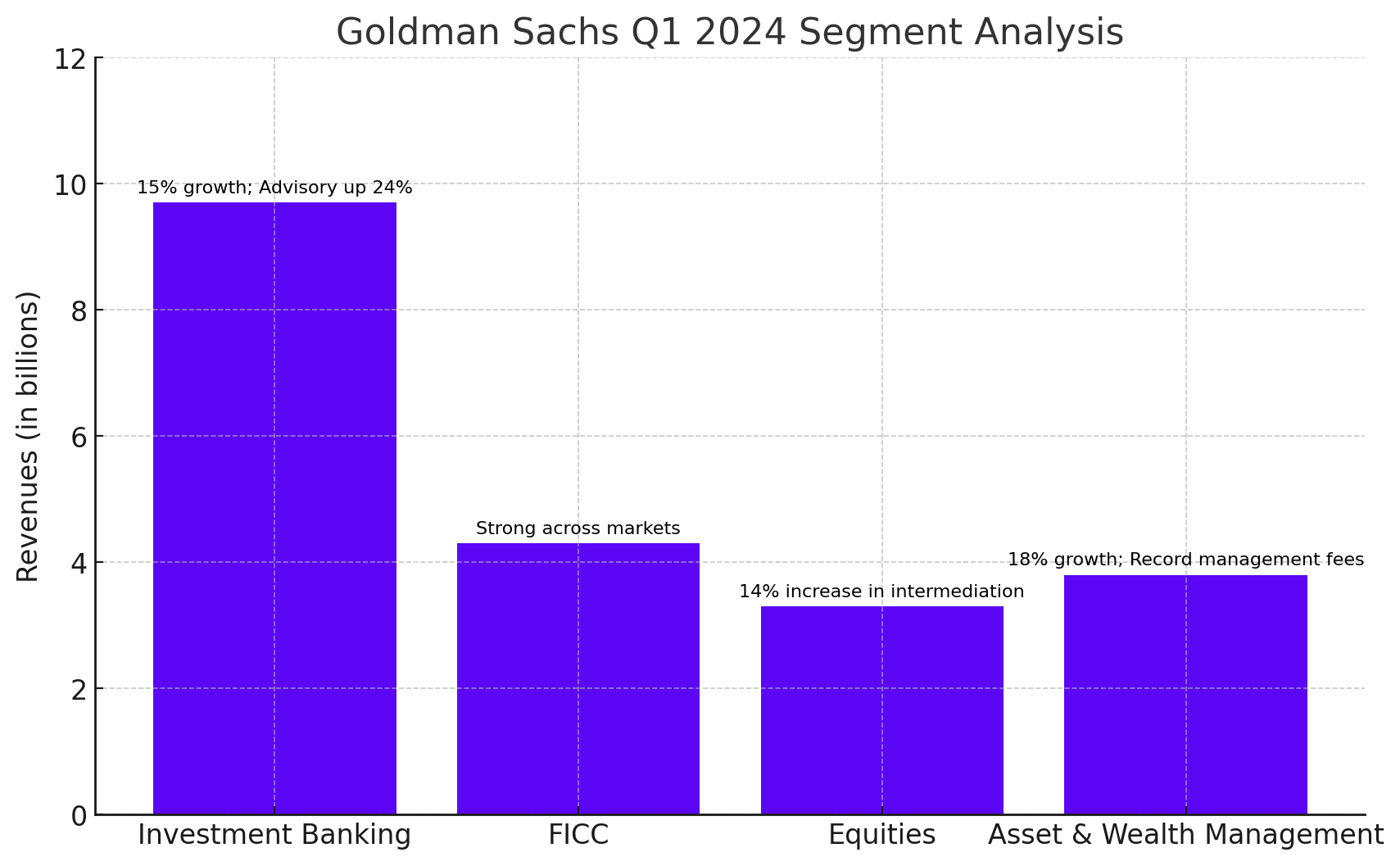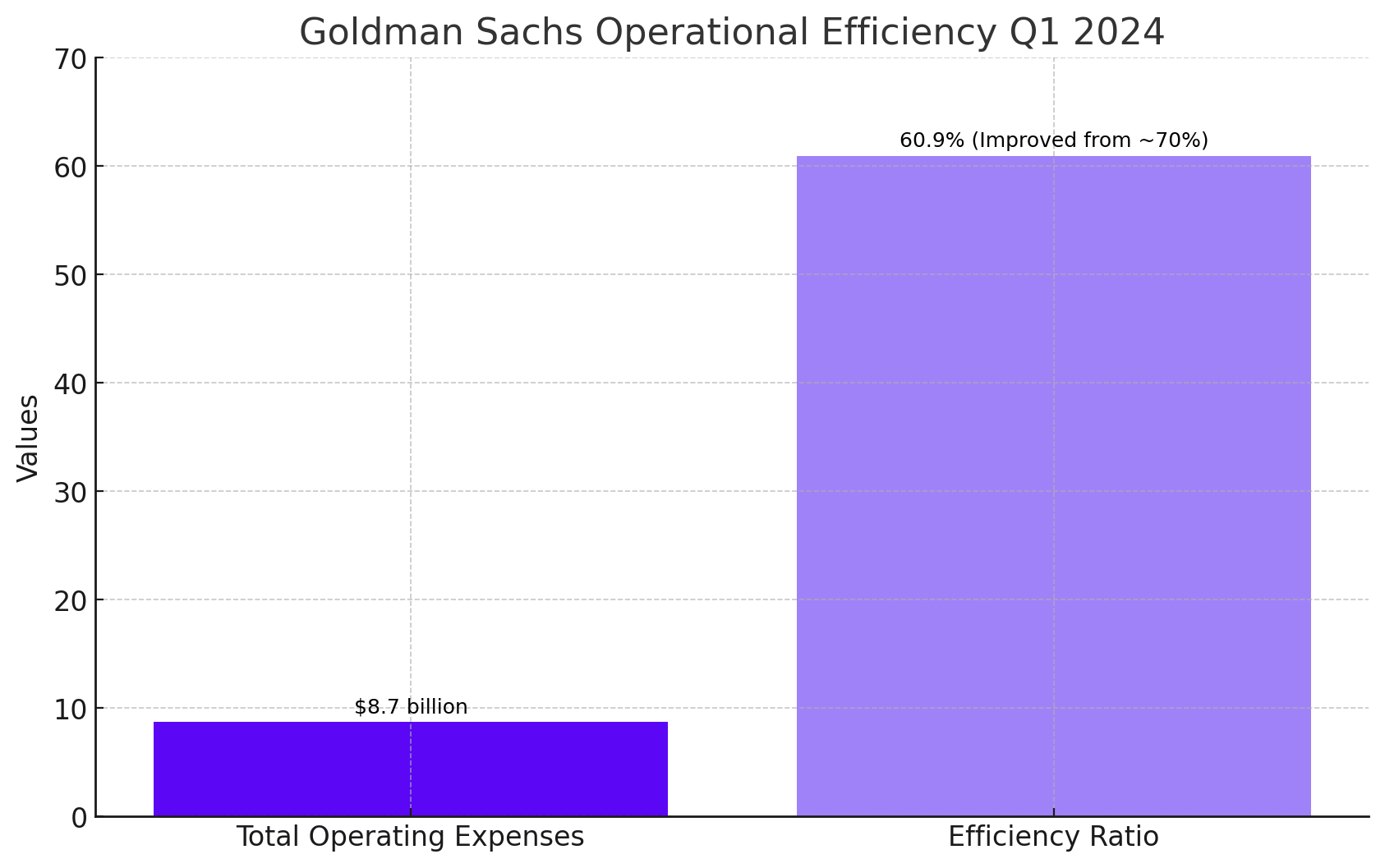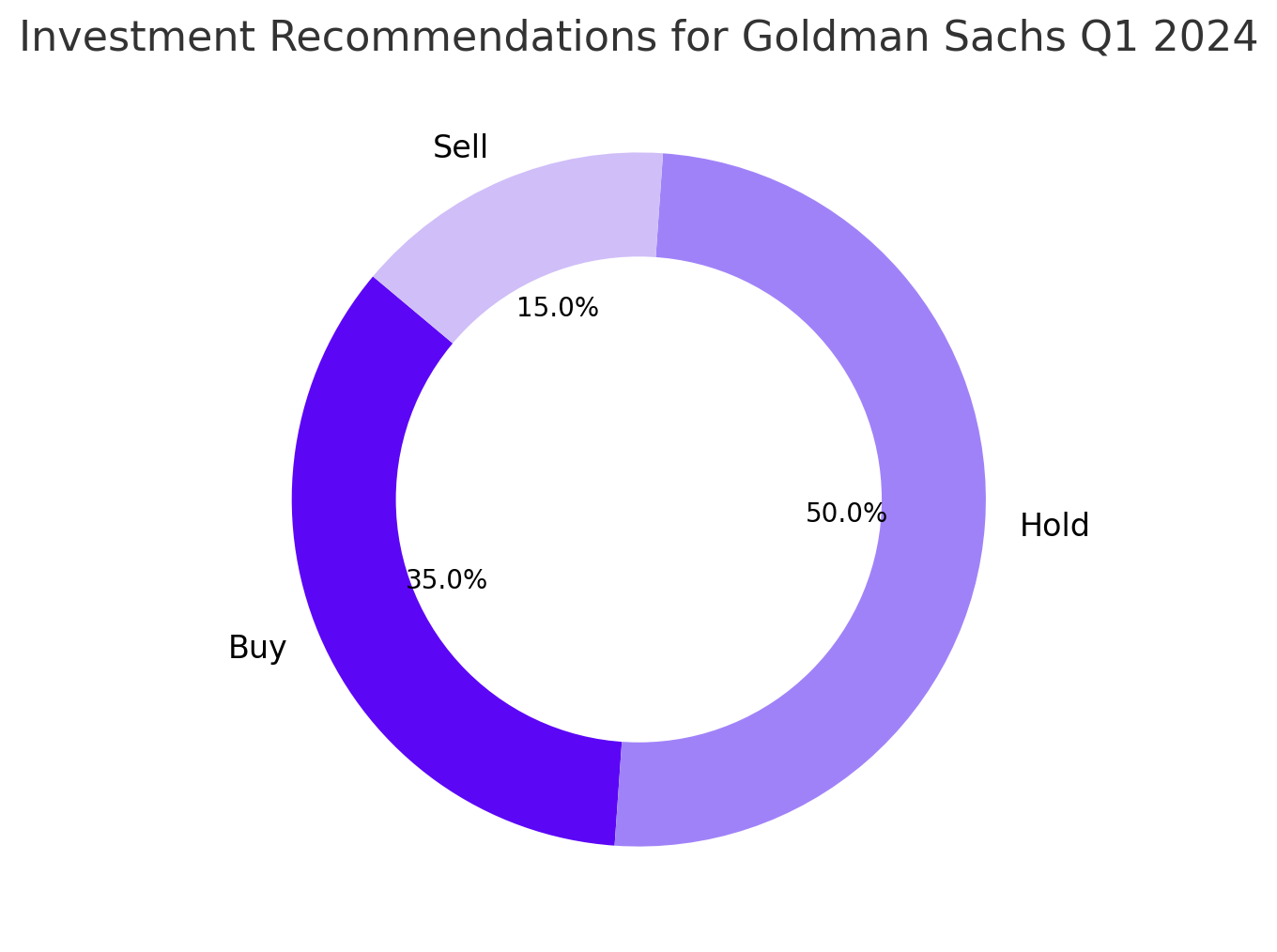
Goldman Sachs Q1 2024 Earnings Analysis - Revenues and Expansions
Delving into Goldman Sachs' financial results, exploring growth in key business segments and strategic investments that position the firm for future success in a dynamic market environment | That's TradingNEWS
Comprehensive Financial Analysis of Goldman Sachs Group Inc. (NYSE:GS)
Overview of Goldman Sachs' Operational Dynamics and Market Position
NYSE:GS has once again demonstrated its prowess in the financial sector with a strong performance in the first quarter of 2024. Known for its robust investment banking, asset management, and strategic market maneuvers, Goldman Sachs continues to leverage its expertise to maintain a competitive edge in the global finance landscape.
Q1 2024 Financial Performance Highlights
Goldman Sachs reported a stellar start to the year with first-quarter net revenues reaching $14.2 billion and net earnings of $4.1 billion, translating into an earnings per share (EPS) of $11.58. This performance exceeded expectations, with revenues surpassing forecasts by $1.28 billion and EPS by $2.90.

In-Depth Segment Analysis
Investment Banking
The Global Banking & Markets segment was a significant contributor, with revenues of $9.7 billion, marking a 15% increase from the previous year. This growth was primarily fueled by a 24% rise in advisory revenue, amounting to $1.0 billion, driven by an increase in completed transactions. Additionally, equity and debt underwriting revenues saw remarkable growth of 45% and 38%, respectively.

Fixed Income, Currency, and Commodities (FICC)
FICC net revenues stood strong at $4.3 billion, benefiting from robust performance across market segments. The equities net revenues reached $3.3 billion, with a 14% increase in intermediation revenues, highlighting Goldman Sachs' strength in trading activities.
Asset and Wealth Management
The Asset & Wealth Management segment reported a revenue of $3.8 billion, up 18% year-over-year. This segment's growth was primarily due to record management and other fees, showcasing the firm's capacity to attract and retain assets under management in a challenging market environment.
Strategic Initiatives and Market Adaptability
Goldman Sachs has been actively expanding its operations beyond traditional banking, venturing into alternative investments and private credit. The firm's asset management arm acquired a significant stake in Kennedy Lewis Investment Management, enhancing its capabilities in private credit and aiming to grow its assets in this sector from $130 billion to $300 billion over the next five years.
Operational Efficiency and Cost Management
The firm reported total operating expenses of $8.7 billion, with an efficiency ratio of 60.9%. This improved efficiency, down from nearly 70% in the previous year, demonstrates Goldman Sachs' effective cost management strategies.

Forward Outlook and Market Opportunities
Goldman Sachs is well-positioned to benefit from the early stages of capital markets reopening, with increased market activity and strong investor appetite expected to drive growth. The firm is also exploring opportunities in artificial intelligence (AI) to enhance productivity and operational efficiencies.
Investment Recommendation: Hold with Cautious Optimism
Despite the positive outlook and impressive Q1 results, the current market valuation and the blend of macroeconomic uncertainties warrant a cautious investment approach. Goldman Sachs is trading at a blended P/E ratio of 15.0x, slightly above its long-term normalized P/E ratio of 12.0x. This valuation reflects high growth expectations that the firm needs to sustain to justify the premium.
Investors are encouraged to maintain a hold position, keeping an eye on potential market fluctuations and the firm's ongoing strategic initiatives. For real-time analysis and stock insights, investors can refer to Goldman Sachs' stock profile on Trading News and stay updated on insider transactions.

Buy: Bullish Outlook
Investors might consider a buy position if they focus on Goldman Sachs' robust Q1 performance, strategic expansion into high-growth areas like private credit and alternative investments, and the effective management of operational costs. The company's proactive moves to diversify revenue streams and capitalize on emerging market opportunities present a bullish case. This stance is supported if one believes that the firm's initiatives will lead to sustainable long-term growth, and if the financial markets maintain their current strength, thereby benefiting Goldman Sachs' core investment banking and asset management sectors.
Hold: Cautiously Optimistic
A hold recommendation is prudent for those who are currently invested and wish to maintain their positions while watching for the unfolding impact of macroeconomic factors and the firm's strategic initiatives. This stance is suitable given the existing uncertainties in the global economic landscape, including interest rate changes and geopolitical tensions which could affect market dynamics and Goldman Sachs' operations. Investors should monitor how well Goldman Sachs continues to manage costs and drive revenue amidst potential market volatility.
Sell: Bearish Consideration
A sell recommendation could be considered if there are concerns about overvaluation relative to historical norms, coupled with the broader market conditions that might lead to underperformance. If investors anticipate a downturn in the financial markets or a slowdown in the capital markets activities that significantly contribute to Goldman Sachs' revenues, reducing exposure might be wise. This perspective might also align with expectations that the current high valuation may not sustain without consistent evidence of growth and profitability improvements.
Conclusion
Given the mixed indicators—strong current performance and strategic positioning against potential macroeconomic headwinds and market euphoria—the most balanced recommendation at this time would be to hold. This position allows investors to benefit from the company's performance and strategic growth while remaining cautious of external factors that might impact the financial sector. Investors should stay updated on economic developments and any changes in Goldman Sachs’ strategic outcomes to adjust their investment stance accordingly. For those outside the stock, the decision to buy should be balanced with consideration of potential higher-for-longer interest rates and their implications on financial stocks.
That's TradingNEWS
Read More
-
SCHD ETF Holds Ground With 3.6% Yield as Dividend Investors Eye Stability Over Growth
15.10.2025 · TradingNEWS ArchiveStocks
-
Ripple XRP (XRP-USD) Steadies at $2.43- SEC Shutdown Freezes ETF Decisions, Inflows Hit $61.6M
15.10.2025 · TradingNEWS ArchiveCrypto
-
NG=F Falls to $2.99 as Record Supply Outpaces Demand Despite 16.9 Bcf/d LNG Exports
15.10.2025 · TradingNEWS ArchiveCommodities
-
USD/JPY Price Forecast - Yen Weakens to 151.30 Amid Dollar Selloff
15.10.2025 · TradingNEWS ArchiveForex


















